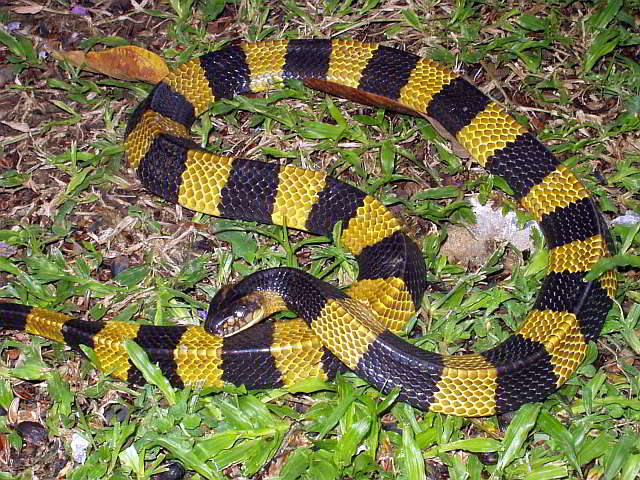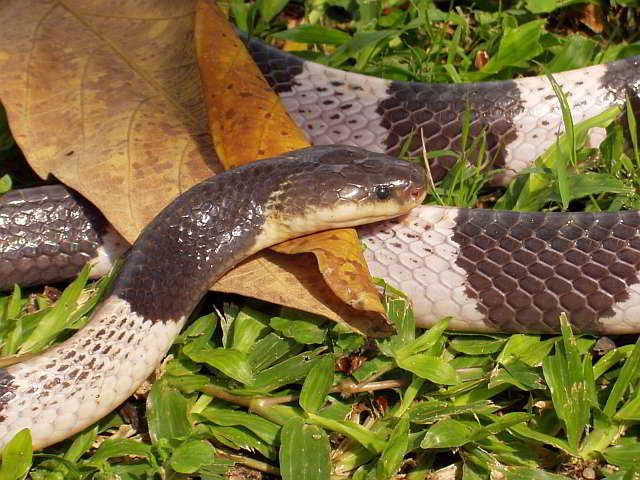 Family: Elapidae (Elapids)
Family: Elapidae (Elapids)Subfamily: Bungarinae
Genus: Bungarus (Kraits)

Picture: J. Bulian
 Bungarus fasciatus (Banded Krait)
Bungarus fasciatus (Banded Krait)Thai:
 (ngu sam laem, ngu kan plong)
(ngu sam laem, ngu kan plong)Length: up to 150 cm
(some authors have reported a maximum length of 200 cm)
Distribution area: Throughout Thailand
Habitat/behaviour: The banded krait is found predominantly in flat and hilly country. However these snakes have also been discovered at heights of 2300 meters. The snakes inhabit open areas, fields, grass landscapes and forests. They are in close proximity to waters quite frequently. Several times I have also found these animals in areas in the south of Thailand, where there was no water for several hundred meters in any direction. The snakes avoid sunlight. If they are exposed to the sun, they thrash around and hide their head under the body loops or try to flee to a dark place. Animals I had found during the day were without exception in damp and cool hiding places, for example under dead fallen down trees, in rotting stumps, or under stones. During the day, the banded kraits are extremely lethargic; so lethargic that bare handed demonstrators on snake farms can even take them out of hiding and display them to the public. According to statistics, however, 50% of bite accidents from this type of snake occur during the day. The predominant food of these snakes is other snakes. In addition, lizards, and rodents are eaten. Fish may also be a part of the diet. These snakes are active at night.
The mating season for this subspecies is in the months of March and April. About 2 months after mating, the female lays 4 to 14 eggs. The females remain with the clutch of eggs until the young animals have hatched. Contrary to pythons these snakes do not “incubate†the eggs but only guard them. The incubation period of the eggs amounts to between 60 and 64 days. The new born animals are between 32 and 34 centimetres long.
Danger level: With regard to toxicity, the venomous of bungarus fasciatus is said to be less effective than the other kraits. This consideration is relative, because reports exist that after the bite of a banded krait death can occur after just 30 minutes. In another documented case, without administration of serum, the bite victim died after only 15 hours.
Note: Danger of mistake with:
● Boiga dendrophila
● Lycodon laoensis
● Dryocalamus
Strong venomous, deadly!


Picture: J. Bulian
 Bungarus candidus (Malayan Krait or Blue Krait)
Bungarus candidus (Malayan Krait or Blue Krait)Thai:
 (ngu tap saming khla, ngu kan plong)
(ngu tap saming khla, ngu kan plong)Length: up to 160 cm
Distribution area: All over Thailand, especially frequently found in the northeast.
Habitat/behaviour: The blue krait settles predominantly in the flat country. They are seldom found over 1200m and frequently live in close proximity to water. The blue krait is also found close to rice fields and rice dams, where it uses the many holes and paths of rats and the nests of mice to hide in. However it can also be found even in villages and cities. The blue krait hides away at night. Like the banded krait, they are somewhat shy. The blue krait is predominantly an ophiophagous, which means that it feeds off other snakes. It will also eat lizards, amphibians, and occasionally even small mammals. There is little known about the reproductive practices of Bungarus candidus. According to some observations, during the mating season the males engage in ritual fighting. Eggs are laid in Thailand in the months of March and April. During this time, gravid females could often be seen on sale from traders at the Bangkok weekend market, in Chatuchakmarkt. On average, four to ten eggs are laid. The young are scarcely 30 centimetres long at birth and correspond in colouring and style to the adults. Under normal conditions the snakes only bite to defend themselves, or if they are stepped on or injured. The venomous of Bungarus candidus is neuro-toxic, as is the venomous of the other Kraits, and thus affects the nervous system of the victim. The same amount of Krait venom as that of the Asian cobras is more lethal.
Danger level: This snake is extremely venomous and generally lethal to victims if bitten.
Strong venomous, deadly!


Picture: J. Bulian
 Bungarus flaviceps (Red-headed Krait)
Bungarus flaviceps (Red-headed Krait)Thai:
 (ngu samläm hua hang däng)
(ngu samläm hua hang däng)Length: Up to 210 cm
Distribution area: Southern Thailand from Ranong
Behaviour/habitat: The Red-headed Krait inhabits the rain forests in mountain and hilly regions. They are hardly ever to be found in humans habitats. This species is very rare. These snakes eat almost exclusively other snakes. Just like the other two Kraits, the Red-headed Krait does not like daylight and is nocturnal. This does not mean that dealing with these snakes during the day is not dangerous. Such animals have also been observed during the day and have even been seen to be eating.
Danger level: Although the Red-headed Krait is too lazy to bite, the venom is very strong and it therefore must be counted as dangerous. In addition, this snake can move very quickly. Strong venomous, deadly!

Mildly-venomous/non-venomous snakes of Thailand
Venomous snakes of Thailand
≡ Menu
All data is provided without guarantee!